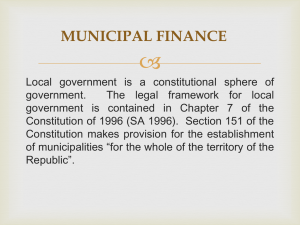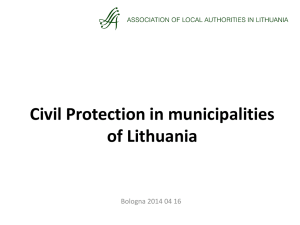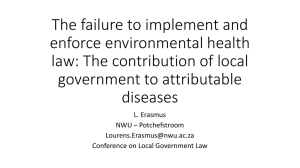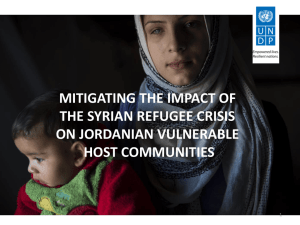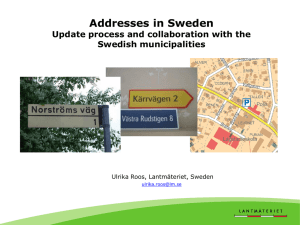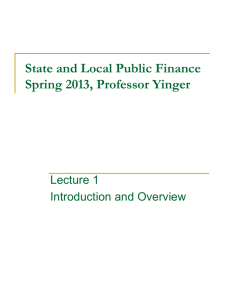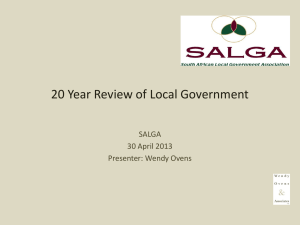Municipality - Multi-level government initiative
advertisement
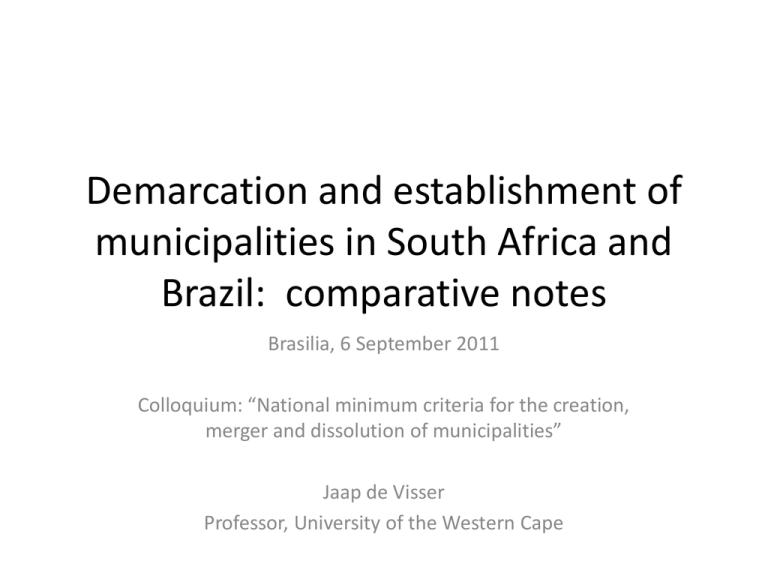
Demarcation and establishment of municipalities in South Africa and Brazil: comparative notes Brasilia, 6 September 2011 Colloquium: “National minimum criteria for the creation, merger and dissolution of municipalities” Jaap de Visser Professor, University of the Western Cape Relevance of South Africa / Brazil comparison • Similarities in socio-economic context / federal features – uneven distribution of wealth (often defined geographically) – ‘young’ democracies, emerging from era of centralisation – LG as a constituent unit of federation with legislative and executive powers – strong role for central govt. vis-à-vis LG – LG receives funds directly from central govt. – RSA: central govt. power limited to setting rules, provinces ‘establish’ LGs (but…) – developmental model of local government some very basic statistics RSA Brazil Population 48 million 190 million Land mass 1,220,813 8,514,877 No. of municipalities 278 5564 Average population/municipality 172 000 34 000 Local Government institutions in South Africa: historical context • Before 1994, municipalities were – – – – – – racially configured subservient to provincial and national government illegitimate fragmented demarcated and designed to exploit black majority • 1996 Constitution: – constitutional recognition of status, powers and revenue authority of LG – uniform system of LG with limited variation between provinces – developmental mandate for LG – democratically elected municipal councils (combination of constituency / party list) Responsibilities • Constitutionally protected powers over issues such as – – – – – – urban and rural land use planning supply of water and sanitation distribution of electricity refuse removal road maintenance municipal health care • many ‘delegated’ functions (e.g. social housing) • LG performs no social welfare functions • Explicit ‘developmental mandate’ Funding • Own revenue – property taxation – surcharges on fees for services • Grants – constitutionally guaranteed ‘equitable share’ (formulabased on poverty data, cost of services etc.) – Unconditional grants (earmarked grants) • Some borrowing by cities • Recent trends – increase in central transfers to LG – dependency on grants varies significantly (urban-rural) – challenge: uncollected debts and maladministration endanger viability of municipalities RSA: rationalisation of number of municipalities after fall of apartheid Before 1994 1994/1995 2000 2006 2011 > 2000 842 284 283 278 RSA: rationalisation of number of municipalities after fall of apartheid Before 1994 > 2000 1994/1995 2000 2006 2011 842 284 283 278 46 DMs 232 LMs 6 MMs 46 DMs 231 LMs 6 MMs 44 DMs 226 LMs 8 MMs • DM=District Municipality comprising of a number of Local Municipalities (LMs) – two tiered system • MM = Metropolitan Municipality – one single municipality Who does what? National Parliament • Legislates on categories of municipalities, governance, finances, minimum standards, formula for division of revenue etc. National Executive • Distributes funds • Supervises municipalities (monitoring and support) Independent Municipal • determines municipal boundaries Demarcation Board • determines metropolitan status (MDB) • determines constituency boundaries Provincial Parliament Oversees Provincial Executive Provincial Executive • establishes municipality in all municipal areas, demarcated by the Board and determines basic governance structures • supervises municipalities (monitoring, support and intervention) Municipal Demarcation Board • Independent institution, appointed by President • Regulated by Municipal Demarcation Act • Main functions: – Demarcate municipal boundaries – Proclaim metropolitan municipalities – Demarcate constituency boundaries • Compare with Brazil: Feasibility Study, Referendum and Decision of State Assembly combined in one independent body Demarcation of municipal boundaries • • • • • • • Section 24 of the Demarcation Act: Objectives of demarcation of municipal boundaries democratic and accountable government equitable and sustainable provision of services promotion of social and economic development promotion of a safe and healthy environment effective local governance integrated development a tax base that is as inclusive as possible of users of municipal services in the municipality. Section 25 of the Demarcation Act: criteria for municipal boundaries PHYSICAL/EXISTING CHARACTERISTICS • current provincial / municipal boundaries; • areas of traditional rural communities; • functional boundaries (magisterial districts, voting districts, health, transport, police etc.); • topographical, environmental and physical characteristics; REDISTRIBUTION/INTEGRATED PLANNING • need for cohesive, integrated and unified areas, including metropolitan areas; • need to share and redistribute financial/administrative resources; • land use, social, economic and transport planning • need for co-ordination across levels of government Section 25 of the Demarcation Act: criteria for demarcating municipal boundaries FINANCIAL VIABILITY • financial viability and administrative capacity • administrative consequences on creditworthiness, councillors and staff SOCIO-ECONOMIC DIMENSION • interdependence of people, communities and economies (patterns of human settlement and migration, employment, commuting and dominant transport movements, spending, the use of amenities, recreational facilities and infrastructure; and commercial and industrial linkages) REFORM • the need to rationalise the total number of municipalities in order to achieve the objectives of effective and sustainable service delivery, financial viability and macro-economic stability. Procedure • Board, Province or Municipality may initiate procedure • Members of public may request Board to start demarcation procedure (but Board may refuse) • Consultative procedure prescribed: public hearings, preliminary findings, right to object etc. • Board’s decision is final (but may be challenged in Court) • Limited number of demarcation disputes – location of a municipality in a particular province (provincial identity, variation in ‘quality’ between provinces) – Constitutional Court has declared certain provincial boundary determinations unconstitutional for lack of public participation (decisions of Parliament) • Generally, decisions of Board are well-respected • Pressure from communities and municipalities absorbed into independent organ Policy debates • What is viability? – Defined only with reference to own revenue? – Does amalgamation in rural areas produce viability? • Metropolitan municipalities ‘too big to fail’? • Size of our municipalities a threat to local democracy? Proliferation of districts in Uganda Uganda: President ‘proclaims’ districts Number of districts from 1990 -2010 Year 1990 1991 1994 1997 2000 2005 2006 2010 No of Districts 34 38 39 45 56 70 79 112 % of growth of Districts 3% 12% 2.6% 15% 24% 25% 13% 42% Proliferation of districts in Uganda Nightmare scenario? Uganda: President ‘proclaims’ districts Number of districts from 1990 -2010 Year 1990 1991 1994 1997 2000 2005 2006 2010 No of Districts 34 38 39 45 56 70 79 112 % of growth of Districts 3% 12% 2.6% 15% 24% Background: 25% • local revenues decreased 13% • unconditional grants equal 42% • conditional grants increased nominally Rough comparison of trend in RSA and Brazil South Africa Before 1994 1994/19995 2000 2006 2011 >2000 842 284 283 278 Brazil 1980 1990 1997 2010 3 991 4491 5507 5564 South Africa: • large scale reform was needed to address apartheid fragmentation • enhanced role for local government necessitated strong political entities • independent board has reduced political factor • legislative criteria emphasise viability and redistribution Minimum population numbers? • Demarcation Board’s experience with maximum deviation ratio for constituency boundaries • Criteria for demarcating constituencies (wards) – every ward in the municipality must have approx. same number of voters – deviation may not be more than 15% – avoid fragmentation of communities – community participation – identifiable boundaries – physical characteristics/ electoral management issues • Numbers game sometimes produced ‘Illogical’ ward boundaries, politically unsustainable units – Board had no choice Determining metropolitan status • Metropolitan status: – single, self-standing municipality – no complex relationship with ‘district municipality’ – status, profile, political status – ability to attract investment • 2000: 6 metro’s (Johannesburg, Cape Town, eThekwini (Durban), Ekurhuleni, Tshwane (Pretoria), Nelson Mandela Bay (Port Elizabeth) • 2011: 2 new metro’s (Buffalo City (East London), Mangaung (Bloemfontein)) • Questions about application of criteria: how objective is it? How objective can it be? Municipal Structures Act: criteria for metropolitan status • • • • • high population density intense movement of people, goods and services extensive development multiple business districts and industrial areas a centre of economic activity with a complex and diverse economy • need for integrated development planning for entire area • strong social and economic linkages between constituent units Structures Act: “high population density” Indicator: population density (number of people/km2) Johannesburg eThekwini Ekurhuleni Cape Town Tshwane Msunduzi Emfuleni Nelson Mandela Bay uMhlathuze Buffalo City 2 227 1 526 1 491 1 338 1 038 930 698 606 520 315 Structures Act: “multiple business districts and industrial areas” Indicator: number of economic hubs Johannesburg Cape Town Ekurhuleni Tshwane Ethekwini Emfuleni Nelson Mandela Bay Emalahleni Mogale City uMhlathuze Buffalo City Mangaung 369 273 206 186 151 36 34 27 24 24 22 22 Structures Act: “Complex and diversified economy” Indicator: gross Value-Added by Region Johannesburg eThekwini Cape Town Tshwane Ekurhuleni Nelson Mandela Bay Rustenburg Buffalo City Mangaung 384 575 088 249 224 112 248 269 693 220 622 529 151 949 868 75 526 865 63 023 141 43 130 440 39 278 475 Structures Act: “commuting patterns” Indicator: vehicle outflow City of Johannesburg City of Cape Town Ekurhuleni Ethekwini City of Tshwane Nelson Mandela Bay Mangaung Buffalo City Emfuleni Msunduzi Mbombela 446 914 381 099 301 640 295 262 290 586 105 461 65 302 59 182 56 997 46 092 40 833 Comparative observations How do criteria compare with Brazil’s process for creation, merger and dissolution? • RSA no formulae / minimum ratios • Independent Demarcation Board • Case-by-case approach to municipal boundaries • discretion, limited by statutory objectives and criteria • emphasis on redistribution and financial viability • consultation but no popular referendum • Demarcation Board controls the ‘trigger’ • Criteria and independence of Board have assisted in creating predictable institutional framework
